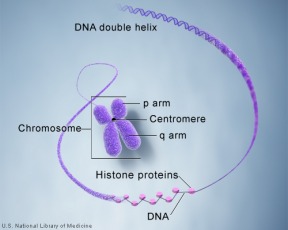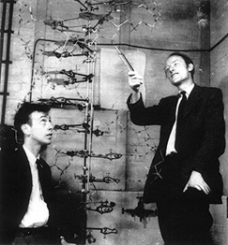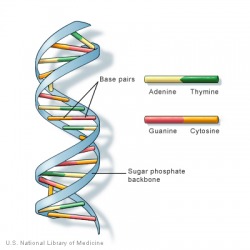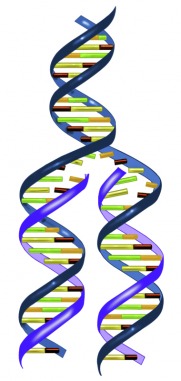20 DNA Answers to 20 Queries and Insights About Deoxyribonucleic Acid

The Double Helix During Replication
DNA is a large macromolecule. It is one of the largest molecules ever discovered. DNA's 3-D molecular structure was first characterized and reported on in Nature in 1953. This section answers 20 DNA questions posed previously here at sciencesuperschool.com. After review of the questions and answers on DNA, National DNA Day in 2010, 2011, and for many years beyond will always be a pleasant and interesting memory, since DNA is what makes the cell what it is. Here are the 20 DNA answers to the 20 DNA questions that serve to remind all of the basic, fundamental DNA information that will never change. Be challenged and be informed by DNA.
DNA, Answers to Queries 1 to 5 for Review About Deoxyribonucleic Acid

Each Chromosome Contains a DNA Double Helix
1. If a typical bacterial cell's DNA is isolated properly the DNA is noted to be of what form or shape? circular (A)
2. If a typical plant's DNA is isolated properly, the DNA is noted to be of what form or shape? linear (B)
3. If typical human DNA is isolated properly, the DNA is noted to be of what form or shape? linear (B)
4. A typical prokaryote, such as Escherichia coli, has how many complete DNA molecules? 1 (one DNA molecule, A)
5. A chromosome if isolated and studied would contain or have DNA. (All chromosomes contain DNA, A)
2. If a typical plant's DNA is isolated properly, the DNA is noted to be of what form or shape? linear (B)
3. If typical human DNA is isolated properly, the DNA is noted to be of what form or shape? linear (B)
4. A typical prokaryote, such as Escherichia coli, has how many complete DNA molecules? 1 (one DNA molecule, A)
5. A chromosome if isolated and studied would contain or have DNA. (All chromosomes contain DNA, A)
DNA, Answers to Queries 6 to 10 for Review About Deoxyribonucleic Acid

James Watson (L) and Francis Crick (R)
6. Which of the following is the correct pairing in DNA? purine to pyrimidine (C). These are typical, normal pairings.
7. Which one of the following is not part of any DNA pairing? arginine (A) is an amino acid, not a nitrogen base.
8. Which TWO terms best define DNA molecules? double helix, composed of nucleotides (B,E)
9. One of the listed scientists is not credited with the discovery of the DNA molecular structure.
Who is that one person? Linus Pauling (E), tried to solve the DNA structure, but thought it was a triple helix.
10. One scientist contributed to the discovery of DNA's structure, but did not receive a Nobel Prize. Who was that scientist?
Rosalind Franklin (D), was an X-ray crystallographer, who worked in Wilkins lab; the Nobel Committee only awards to
a maximum of 3 investigators for any award category, and they judged Watson, Crick and Wilkins as most deserving.
7. Which one of the following is not part of any DNA pairing? arginine (A) is an amino acid, not a nitrogen base.
8. Which TWO terms best define DNA molecules? double helix, composed of nucleotides (B,E)
9. One of the listed scientists is not credited with the discovery of the DNA molecular structure.
Who is that one person? Linus Pauling (E), tried to solve the DNA structure, but thought it was a triple helix.
10. One scientist contributed to the discovery of DNA's structure, but did not receive a Nobel Prize. Who was that scientist?
Rosalind Franklin (D), was an X-ray crystallographer, who worked in Wilkins lab; the Nobel Committee only awards to
a maximum of 3 investigators for any award category, and they judged Watson, Crick and Wilkins as most deserving.
DNA, Answers to Queries 11 to 15 for Review About Deoxyribonucleic Acid

DNA Double Helix and AT and GC Nitrogen Base Pairs
11. Which type bond is involved between any two paired nitrogen bases of DNA? hydrogen (B); attraction of the hydrogen nucleus for electronegative atoms.
12. Which type bond links the sugar to the phosphate in DNA? covalent (C); stongest bond, shared electrons.
13. Indicate which 2 features of the sugar apply to DNA molecules? ribose with a missing oxygen, (A, E) = deoxyribose
14. DNA would be what kind of molecule when analyzed chemically? acid (A)
15. The strength of the bondings between paired nitrogen bases (as asked in question 11) are dependent on type pairing (B), because AT bondings are two hydrogen bonds, and GC involve 3 hydrogen bonds and are stronger.
12. Which type bond links the sugar to the phosphate in DNA? covalent (C); stongest bond, shared electrons.
13. Indicate which 2 features of the sugar apply to DNA molecules? ribose with a missing oxygen, (A, E) = deoxyribose
14. DNA would be what kind of molecule when analyzed chemically? acid (A)
15. The strength of the bondings between paired nitrogen bases (as asked in question 11) are dependent on type pairing (B), because AT bondings are two hydrogen bonds, and GC involve 3 hydrogen bonds and are stronger.
DNA, Answers to Queries 16 to 20 for Review About Deoxyribonucleic Acid

Semiconservative DNA Replication
16. DNA replicates in what manner? semiconservative (C). Each 1/2 strand makes a new complimentary strand.
17. A scientist compares the DNA replication of bacteria, plants and animals and notes the replications are?
similar in each (A). Semiconservative replication is the rule for all life forms for DNA.
18. Genes can be defined as a distinct and discrete number of nucleotides (C).
19. Genes usually are shut down or promoted to work as a direct result of what type molecular interaction with the gene?
protein (C) control. Proteins are used as "repressor proteins" to react at gene sites and shut them down.
20. If a gene mutates it: changes (D); base pair changes, deletions, inversions, subtitutions. Mutations may be neutral, harmful, or
beneficial.
All the Written Material within Site is Copyrighted 2010 and Owned by Dr. Donald Reinhardt, and this original material is protected legally by this copyright notice and by the Digital Millennium Act. None of this original material may be copied or reproduced without the expressed written consent of the author.
The author is a Freelance Science writer, and is available for specific assignments for those who are interested – by contacting adminstrator@sciencesuperchool.com. Other questions related to this teaching site should be directed to teacher@sciencesuperschool.com.
17. A scientist compares the DNA replication of bacteria, plants and animals and notes the replications are?
similar in each (A). Semiconservative replication is the rule for all life forms for DNA.
18. Genes can be defined as a distinct and discrete number of nucleotides (C).
19. Genes usually are shut down or promoted to work as a direct result of what type molecular interaction with the gene?
protein (C) control. Proteins are used as "repressor proteins" to react at gene sites and shut them down.
20. If a gene mutates it: changes (D); base pair changes, deletions, inversions, subtitutions. Mutations may be neutral, harmful, or
beneficial.
All the Written Material within Site is Copyrighted 2010 and Owned by Dr. Donald Reinhardt, and this original material is protected legally by this copyright notice and by the Digital Millennium Act. None of this original material may be copied or reproduced without the expressed written consent of the author.
The author is a Freelance Science writer, and is available for specific assignments for those who are interested – by contacting adminstrator@sciencesuperchool.com. Other questions related to this teaching site should be directed to teacher@sciencesuperschool.com.
Click Here for 20 DNA Questions for National DNA Day, or Any Day